Portuguese custard tarts with puff pastry or “pasteis de nata” are a specialty pastry all over the beautiful country of Portugal. With a cinnamon and citrus flavored custard nestled in a flaky puff pastry crust they are highly addictive, so don't expect to stop at just 1 or 2 or 3 🙂
This custard is made without corn flour, cream or vanilla extract. It is thickened instead with plain flour and the creamy texture is from the combination of the thickened milk, syrup and egg yolks. The custard is flavored with cinnamon and a hint of lemon. This combination creates that amazing authentic flavor.
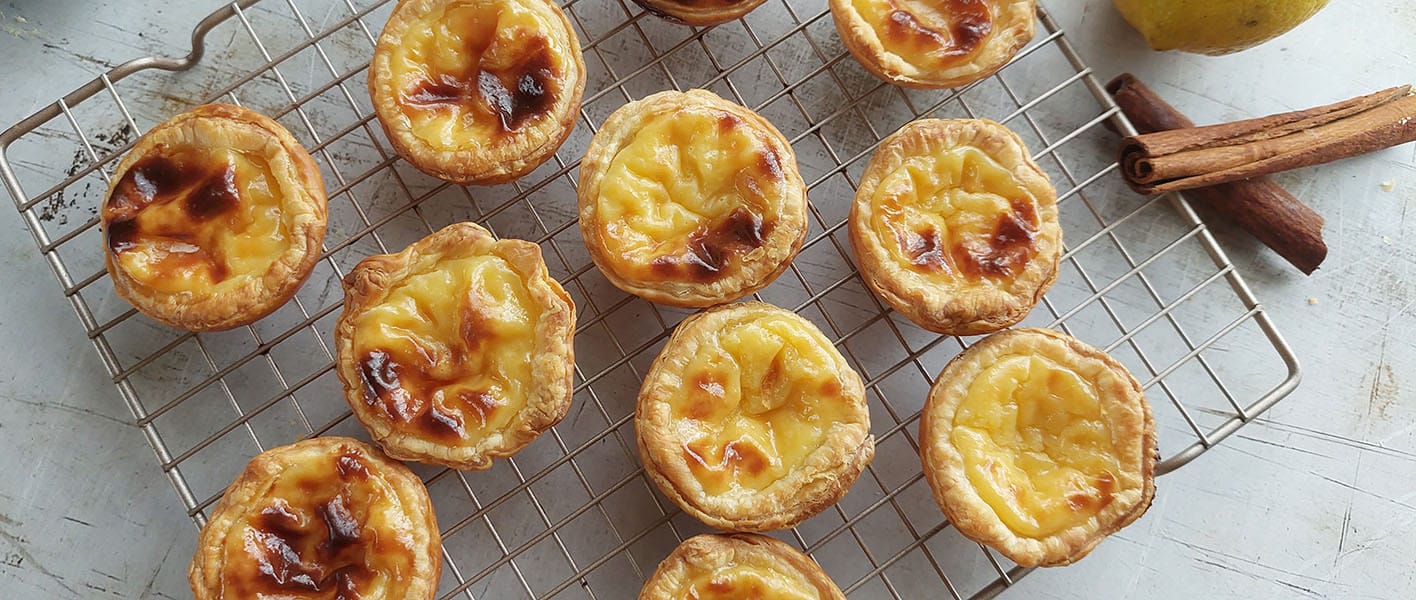
What are Portuguese Custard Tarts - Pastéis de Nata?
Pastéis de Nata are Portuguese custard tarts made with puff pastry and filled with egg custard.
As it bakes, the filling thickens, the crust gets crispy, and those golden brown spots appear on the top of the custard. These little delights can be served with a dusting of powdered sugar and a pinch of cinnamon.
Traditional recipes are made using homemade puff pastry. If you are able or prefer to make to make your own puff pastry for this recipe, then go for it too.
I however opted for the pre made puff pastry. The filling ingredients and method, I tried to keep as authentic as possible to create the creamiest, most delicious custard.
Enjoy them warm and freshly baked if possible. The crispiness of the pastry will be gone by the next day or so.
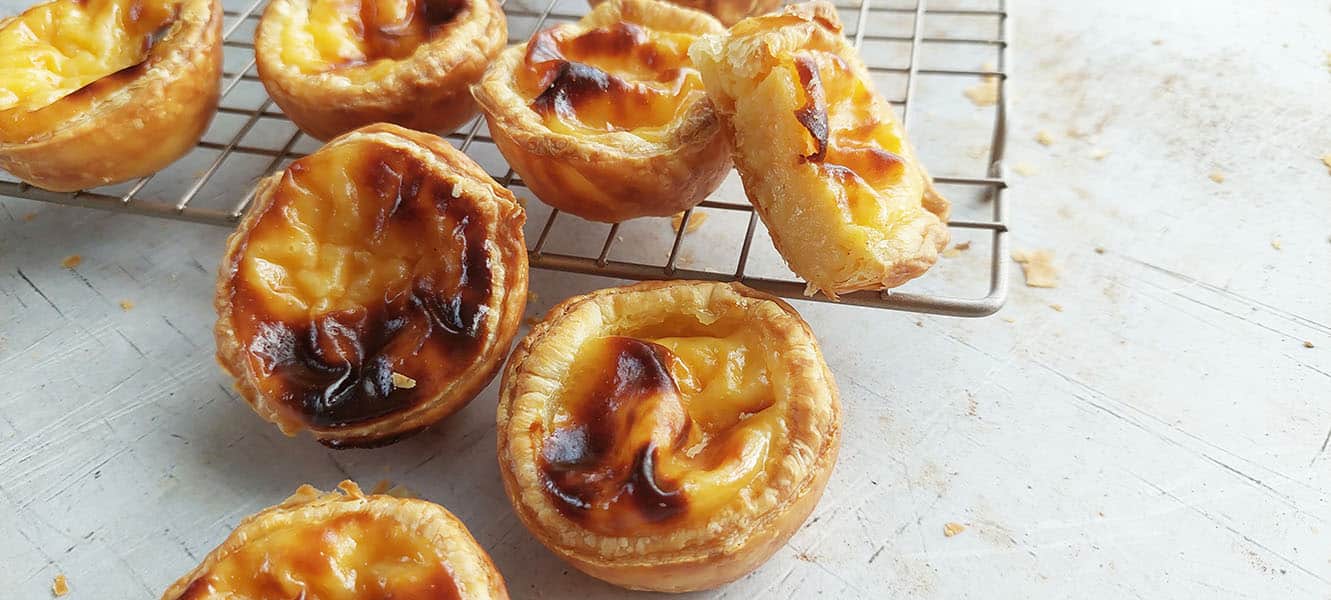
How to make Portuguese Custard tarts
This is a detailed post with instructions and image steps no matter how small. If it is your first time making the Portuguese custard tarts. I encourage you to read through this guide. The post will explain the importance and reasons of the steps for a successful bake.
The full printable recipe with ingredient, amounts and instructions are right at the end of this post.
After the first time making this recipe, you will be a pro at it, whipping out bakery style bakes every time.
The Pastry
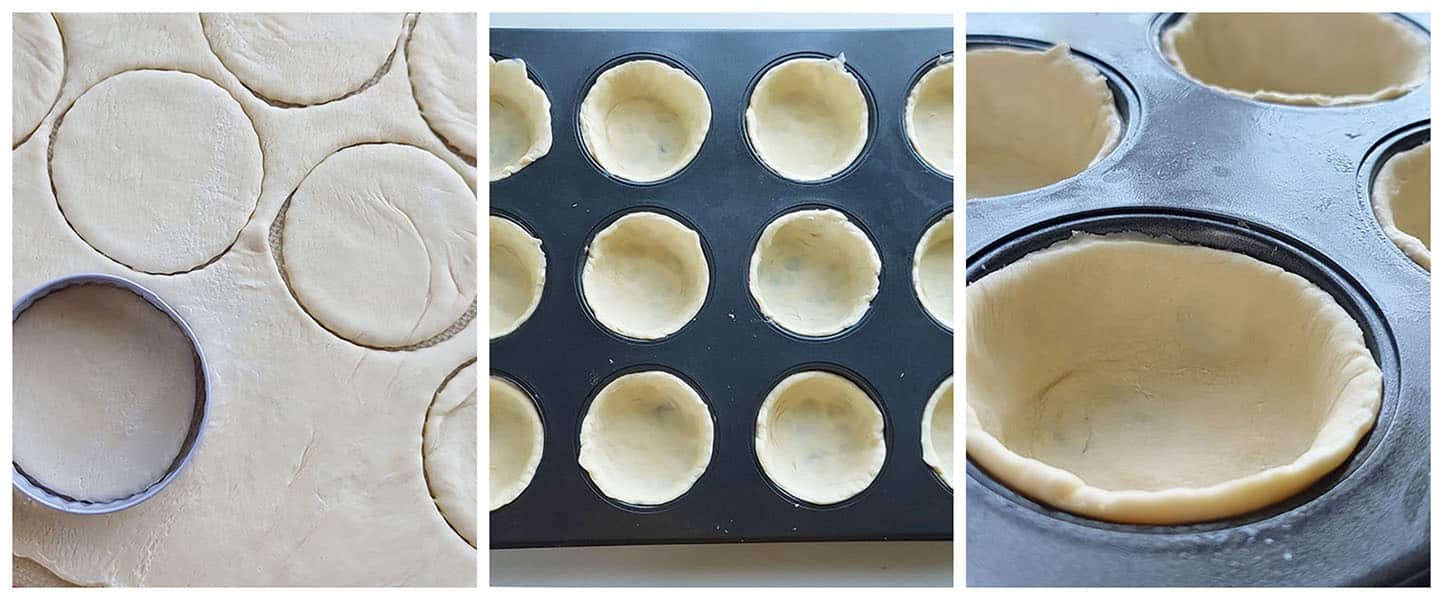
The Pastry
- Lightly flour a work surface and cut puff pastry into roughly 12 equal rounds using a 3 ½ inch (roughly 8 ½ to 9 cm) cookie cutter.
-
Use cooking spray or melted butter to lightly grease 12 egg tart molds OR a 12 cup regular muffin pan.
-
Press each piece of puff pastry down and up onto the sides of the muffin holes until evenly distributed.
- Place the molds or muffin pan with the pastry in the refrigerator while you prepare the syrup and custard.
- Its important that the puff pastry dough be cold in the molds or muffin tin before filling with the warm custard. Refrigerating keeps the butter in the pastry firm and cold. When its time to fill, the warm custard will not soak into it. This will prevent a soggy crust. You want a flaky crust, not soggy. The filled pastry must then be placed in the preheated oven right after you pour the custard, because if you wait and let them sit, the custard will seep into the shells and the bottoms may get soggy.
The custard filling consist of 3 parts:
- The syrup
- The milk and flour mixture
- The egg yolks
The syrup
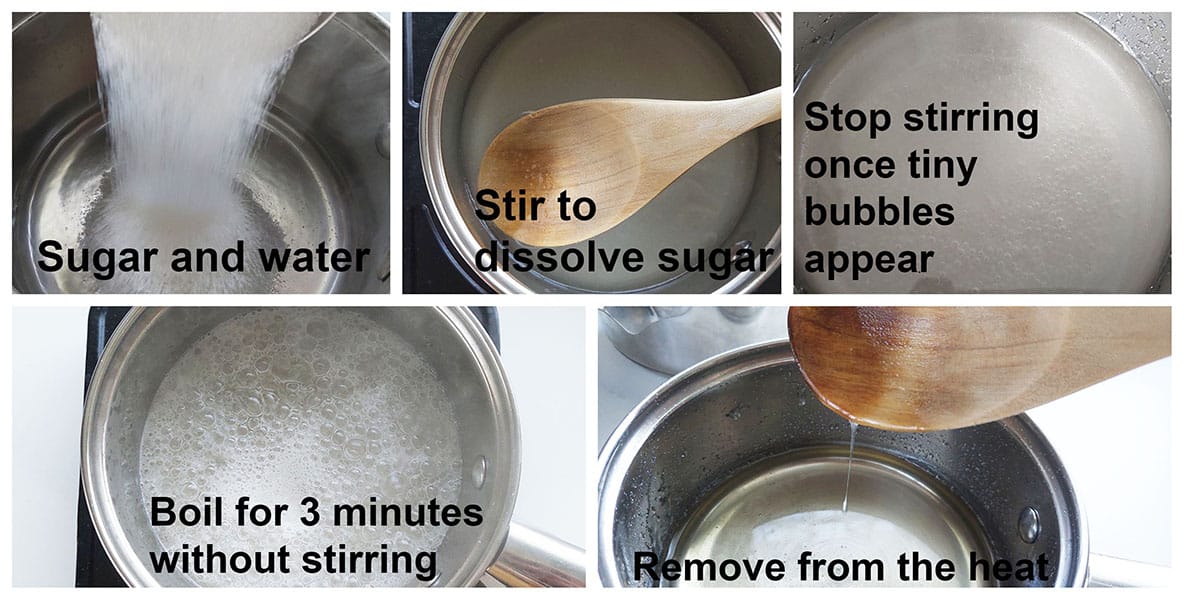
- Add water and sugar to a small pot and place on the stove. Turn the heat up to medium and stir for about 1 minute to dissolve the sugar.
- When you see tiny bubbles appear on the surface of the pot, set a timer to 3 minutes.
- During these 3 minutes, leave the syrup to boil WITHOUT stirring.
- Turn the stove off, take the pot off the stove and set aside while you prepare the custard. The syrup will continue to thicken as it cools. This is normal and will be at the perfect consistency when it is time to mix into the custard.
The milk and flour mixture
- Pour half of the measured milk into the bowl with the flour. Whisk until smooth and the flour dissolved.
- Add the cinnamon stick, lemon peel and remaining milk to a medium sized pot.
- Place the pot on to the stove and heat for 1 minute on a medium setting.
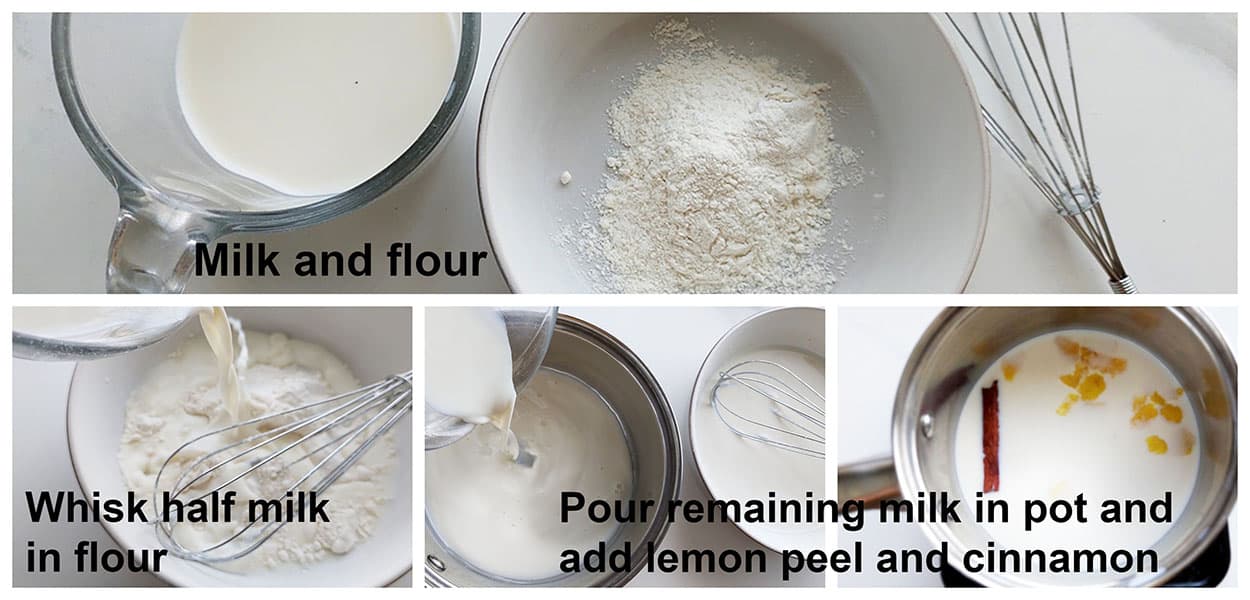
- Leave the pot on the heat and slowly add in the the dissolved flour mixture while whisking continuously.
- Within approximately 1 minute you will notice the mixture thickening.
- Turn off the stove or gas and take the pot off the stove.
- Pour the syrup into the thickened milk mixture and whisk for about 1 minute, until smooth.
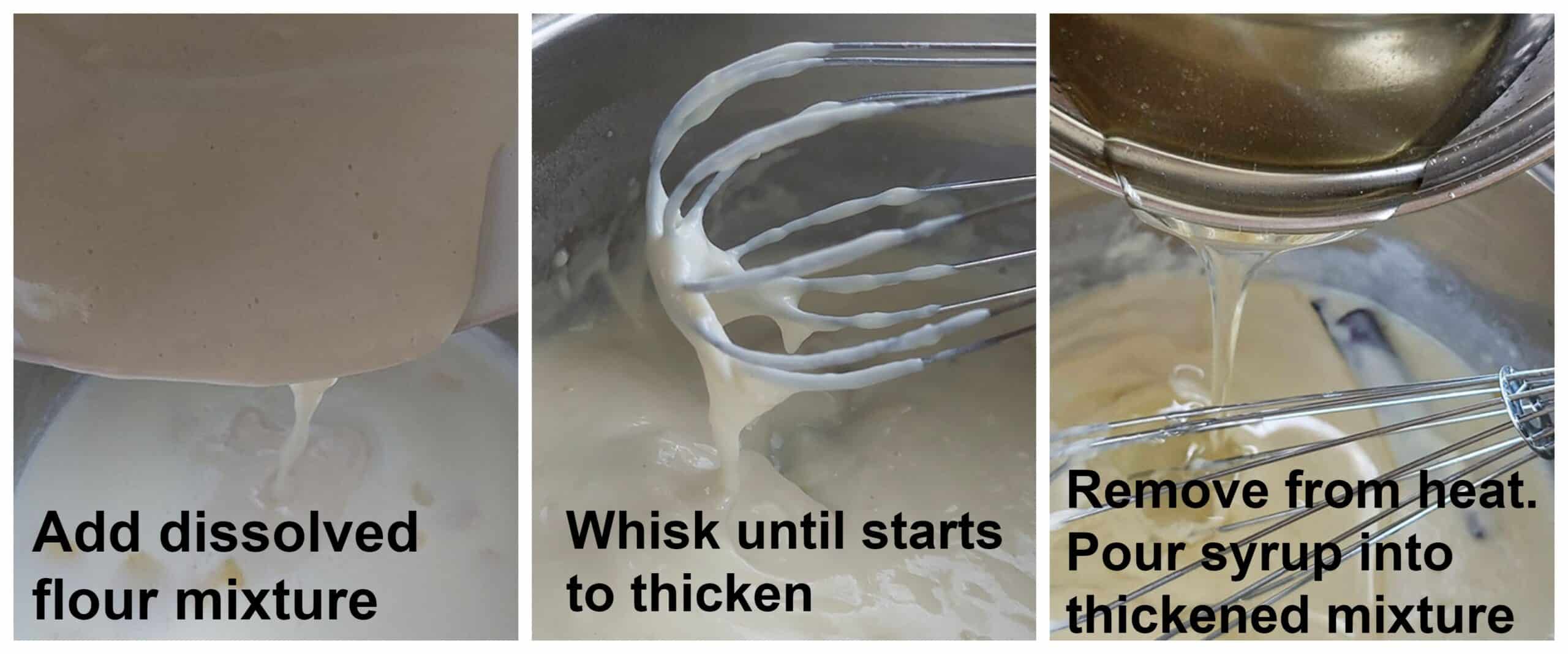
The egg yolks
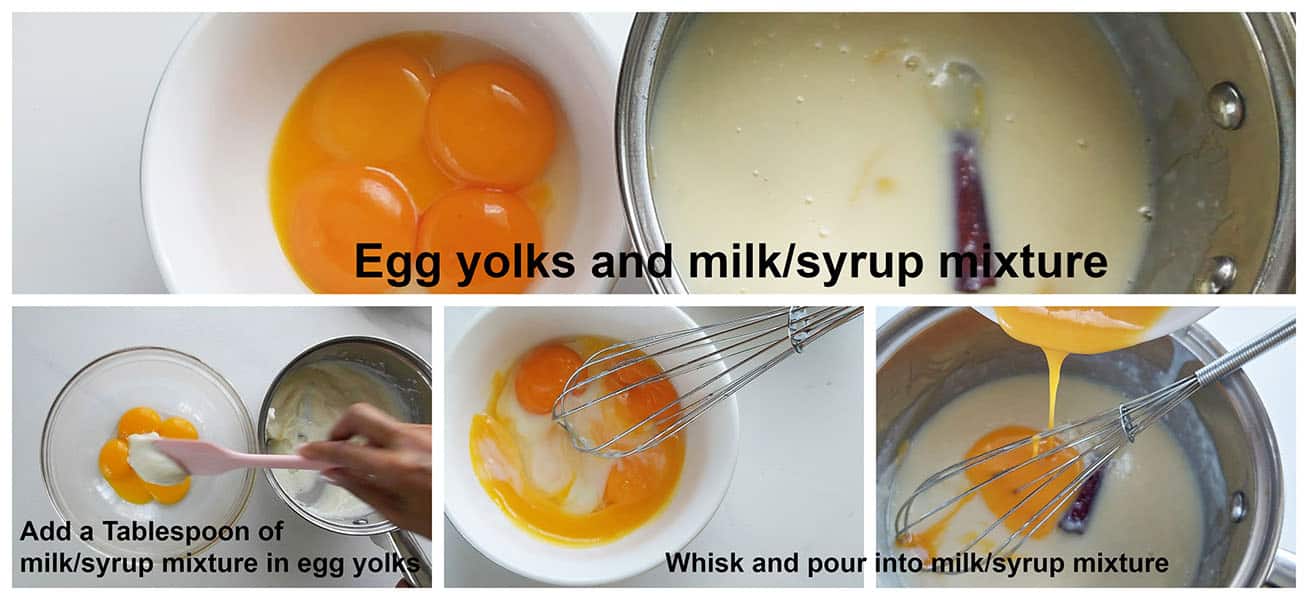
- Pour about a tablespoon of the combined milk/syrup mixture into the bowl with the egg yolks. Whisk for 10 seconds until combined.
This is referred to as tempering the eggs. Its when a little of the hot liquid is added to the eggs.
This brings the eggs to approximately the same temperature of the hot mixture. The tempered eggs are now stable enough to be added to the rest of the hot mixture without the risk of it curdling or scrambling.
- Return the tempered egg yolks to the pot with the milk/syrup mixture. Do not put the pot back on to the stove or heat
Whisk for 1 minute to form a smooth custard. Don't worry if the custard doesn't look very thick now. This is normal and will thicken and set once it has baked.
Strain the custard
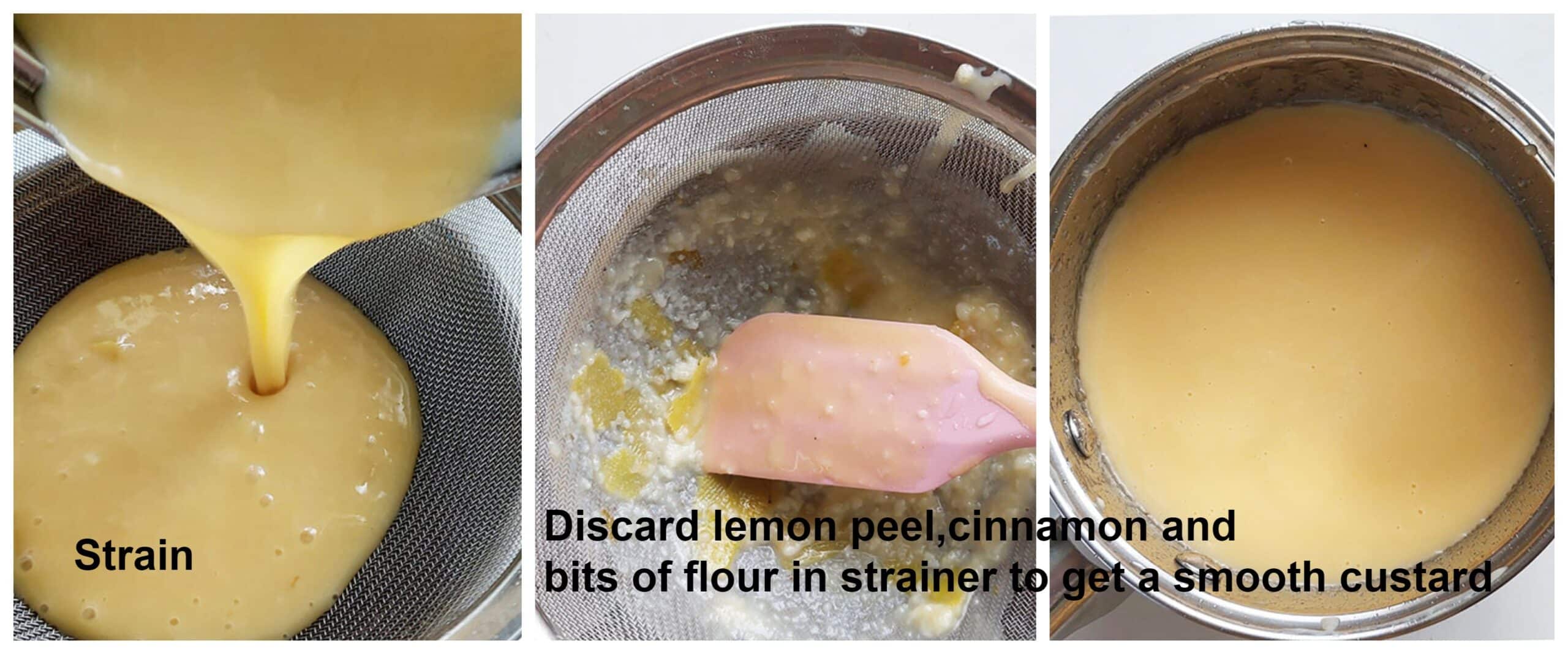
- Place a sieve or strainer over a measuring jug or bowl. Pour the custard through the sieve.
This is so that you are left with a smooth custard as it passes through the sieve. Any bits of flour that might not have dissolved will be caught in the strainer.
Discard the cinnamon stick, lemon peel and any bits of flour caught in the strainer.
Assemble and bake
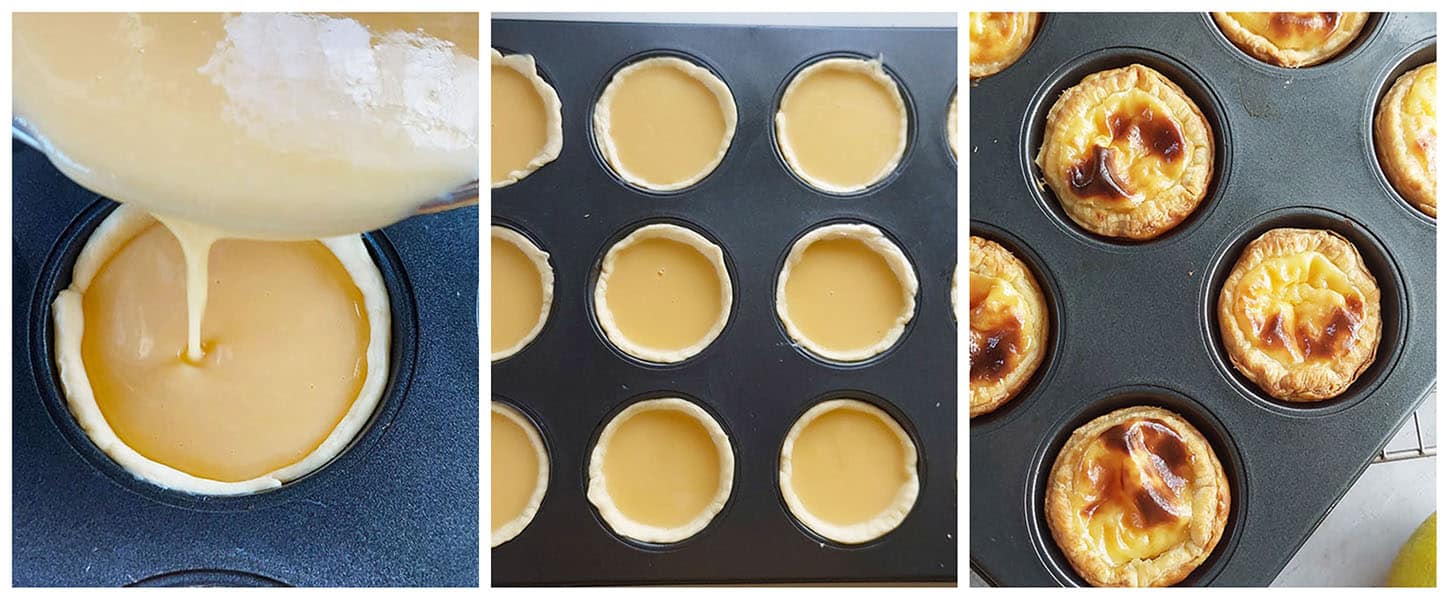
- Pre heat the oven to 470°F (240°C) 220° (fan).
- Get the cold molds or muffin tin lined with the puff pastry out of the refrigerator.
- Fill the puff pastry cases up to ¾ full. The custard will not spill over the cases as it bakes. It will thicken and puff up while baking, then deflate and shrink back down as it cools.
- Immediately after filling, place the filled pastry cases into the very hot preheated oven.
- Bake for between 18 to 25 minutes until the shells are golden brown and crisp. The custards will be set, and the tops blackened in spot. Let cool in the pans on wire racks for 5 minutes. Then, remove the molds, transfer the tarts to the wire racks and sprinkle with cinnamon. Serve warm.
Don't be alarmed if you see the custard puff up while baking. This is normal, they will puff up then deflate and shrink back down as it cools.
Remember all ovens behave differently. If after the baking time you do not see that scorched custard top, its still perfectly fine.
Your custard tarts are baked and will taste just great.
However if you still do want that classic or iconic look, then simply place the baked tarts under the hot grill or broiler for just a few seconds.
Watch as it browns, do not walk away from your oven. Do not leave under the grill/broiler for more than 1 minute. Once browned, remove from the oven.
Storage
-
Do Portuguese Egg tarts need to be refrigerated?
Freshly baked Portuguese custard egg tarts do not need to be refrigerated if being served the same day.
If you plan to serve the following day it is best to keep the egg tarts refrigerated since they do contain a high about of milk and egg yolk. They can be refrigerated for up to 5 days in an airtight container.
-
How long can you keep Portuguese Egg Tarts?
Homemade Portuguese custard tarts can be kept covered in your refrigerator for up to 5 days.
-
Can You Freeze Portuguese Custard Tarts?
The texture of the baked custard tarts degrade rapidly and splits the longer they are left in the freezer. I would advise only storing them frozen for up to a month.
Beyond this point, they’ll become grainy and the custard sometimes splits. . As always, make sure you take time to label your frozen tarts so you know when to consume them by.
-
How do you reheat Portuguese Egg Tarts?
Portuguese custard tarts can be eaten cold. If you prefer it warmed, this can be done in the microwave for a few seconds or reheated in the oven:
To reheat and crisp up your Portuguese egg tart from the refrigerator simply preheat your oven to 350°F (175°C) and bake for 6-8 minutes. If reheating from frozen, then bake for 13-15 minutes.
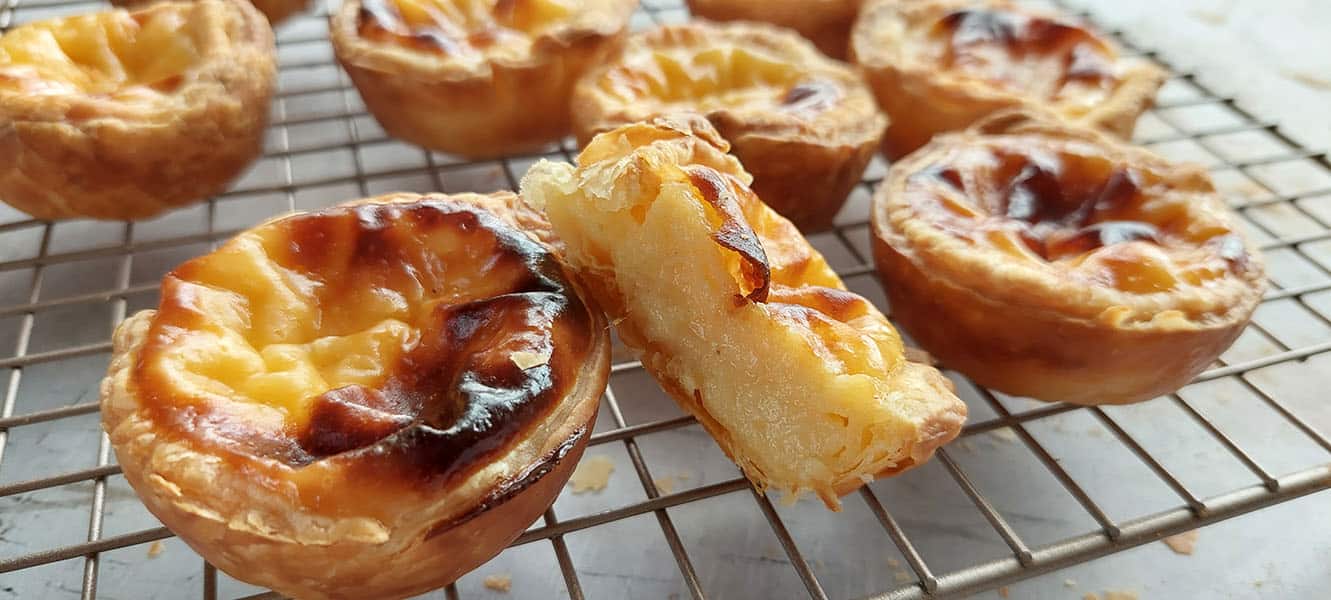
Frequently asked questions?
-
What type of pastry can I use for Portuguese custard tarts?
Traditional recipes are made using homemade puff pastry. If you are able or prefer to make to make your own puff pastry for this recipe, then go for it too. I however opted for the pre made / ready rolled puff pastry.
DO NOT use short crust pastry. Puff pastry is recommended which produces a flaky baked crust.
-
What can I use instead of cinnamon sticks?
If you don't have any cinnamon sticks, then simply add a ¼ teaspoon of cinnamon powder to the custard instead of a stick. Alternately you can sprinkle cinnamon powder over the baked Portuguese tart.
-
Is it normal for the custard to puff up while baking then deflate when cool?
Yes to both. Don't be alarmed if you see the custard puff up while baking. This is normal, they will puff up then deflate and shrink back down as it cools.
-
Why don't I see the iconic scorched custard top after baking?
Remember all ovens behave differently. If after the baking time you do not see that scorched custard top, its still perfectly fine.
Your custard tarts are baked and will taste just great. However if you still do want that classic or iconic look, then simply place the baked tarts under the hot grill or broiler for just a few seconds.
Watch as it browns, do not walk away from your oven. Do not leave under the grill/broiler for more than 1 minute. Once browned, remove from the oven.
-
What is tempering the eggs yolks and why is it important?
Tempering egg yolks is a quick and simple but important step. It's when a little of the hot liquid is added to the eggs.
This brings the eggs to approximately the same temperature of the hot mixture. The tempered eggs are now stable enough to be added to the rest of the hot mixture without the risk of it curdling or scrambling.
-
Can I prepare the custard in advance?
Yes, the custard can be prepared and refrigerated up to 1 day in advance.
Enjoy ♥
Follow on Facebook, Pinterest, and Instagram or Subscribe for the latest recipe updates
Ingredients
Pastry
- 14 ounce / 1 ounce /400g ready rolled, store bought or homemade puff pastry See note 1
Syrup
- ¾ (150g) white granulated sugar
- ⅓ cup (75 ml) water
Milk and Flour mixture
- 1 cup (250ml) whole / full fat milk (divided in half)
- 3 ¾ Tablespoon (30g) plain or all-purpose flour
- 1 stick cinnamon see note 2
- Peel only of one medium size lemon
Egg yolks
- 4 large egg yolks only
Instructions
The Pastry
- Lightly flour a work surface and cut puff pastry into roughly 12 equal rounds using a 3 ½ inch (roughly 8 ½ to 9 cm) cookie cutter.
- Use cooking spray or melted butter to lightly grease 12 egg tart molds OR a 12-cup regular muffin pan.
- Press each piece of puff pastry down and up onto the sides of the muffin holes until evenly distributed.
- Place the molds or muffin pan with the pastry in the refrigerator while you prepare the syrup and custard. See note 3
Make The syrup
- Add water and sugar to a small pot and place on the stove. Turn the heat up to medium and stir for about 1 minute to dissolve the sugar.
- When you see tiny bubbles appear on the surface of the pot, set a timer to 3 minutes.
- During these 3 minutes, leave the syrup to boil WITHOUT stirring.
- Turn the stove off, take the pot off the stove and set aside while you prepare the custard. The syrup will continue to thicken as it cools. This is normal and will be at the perfect consistency when it is time to mix into the custard.
Make the milk and flour mixture
- Pour half of the measured milk into the bowl with the flour. Whisk until smooth and the flour dissolved.
- Pour the remaining milk into a medium sized pot and add in the cinnamon stick, lemon peel.
- Place the pot on to the stove and heat for 1 minute on a medium setting.
- Leave the pot on the heat and slowly pour in the the dissolved flour mixture while whisking continuously.
- Within approximately 1 minute you will notice the mixture thickening. As soon as it starts to thicken, turn off the stove or gas and take the pot off the heat.
- Pour the syrup into the thickened milk mixture and whisk for about 1 minute, until smooth.
The egg yolks
- Pour about a tablespoon of the combined milk/syrup mixture into the bowl with the egg yolks. Whisk for 10 seconds until combined.
- This is referred to as tempering the eggs. It's when a little of the hot liquid is added to the eggs. This brings the eggs to approximately the same temperature of the hot mixture. The tempered eggs are now stable enough to be added to the rest of the hot mixture without the risk of it curdling or scrambling.
- Pour the tempered egg yolks into the pot with the milk/syrup mixture. Do not place the pot back on to the stove or heat
- Whisk for 1 minute to form a smooth custard. Don't worry if the custard doesn't look very thick now. This is normal and will thicken and set once it has baked.
Strain the custard
- Place a sieve or strainer over a measuring jug or bowl. Pour the custard through the sieve.
- This is so that you are left with a smooth custard as it passes through the sieve. Any bits of flour that might not have dissolved will be caught in the strainer.
- Discard the cinnamon stick, lemon peel and any bits of flour caught in the strainer.
Assemble and bake
- Pre heat the oven to a very hot 470°F (240°C) 220° (fan).
- Get the cold molds or muffin tin lined with the puff pastry out of the refrigerator.
- Fill the puff pastry cases just under ¾ full. The custard will not spill over the cases as it bakes. It will thicken and puff up while baking, then deflate and shrink back down as it cools.
- Immediately after filling, place the filled pastry cases into the very hot preheated oven.
- Bake for between 18 to 25 minutes until the shells are golden brown and crisp. See note 4
- The custards will be set, and the tops scorched with spots. See note 5
- Remove from the oven and leave to cool in the pan on a wire rack for 5 minutes. Then, remove the tarts from the pan or molds and transfer to a wire rack.
- Sprinkle with cinnamon if you prefer. Serve warm.
Storage
- At room temperature: 1 to 2 days in an airtight container
- In the refrigerator: Up to 5 days in an airtight container.
- In the freezer: The texture of the baked custard tarts degrades rapidly the longer they are left in the freezer. I would advise only storing them frozen for up to a month.
- Beyond this point, they’ll become grainy and the custard sometimes splits. As always, make sure you take time to label your frozen tarts so you know when to consume them by.
How to reheat
- Portuguese custard tarts can be eaten cold. If you prefer it warmed, this can be done in the microwave for a few seconds or reheated in the oven:
- To reheat and crisp up your Portuguese egg tart from the refrigerator simply preheat your oven to 350°F (175°C) and bake for 6-8 minutes. If reheating from frozen, then bake for 13-15 minutes.

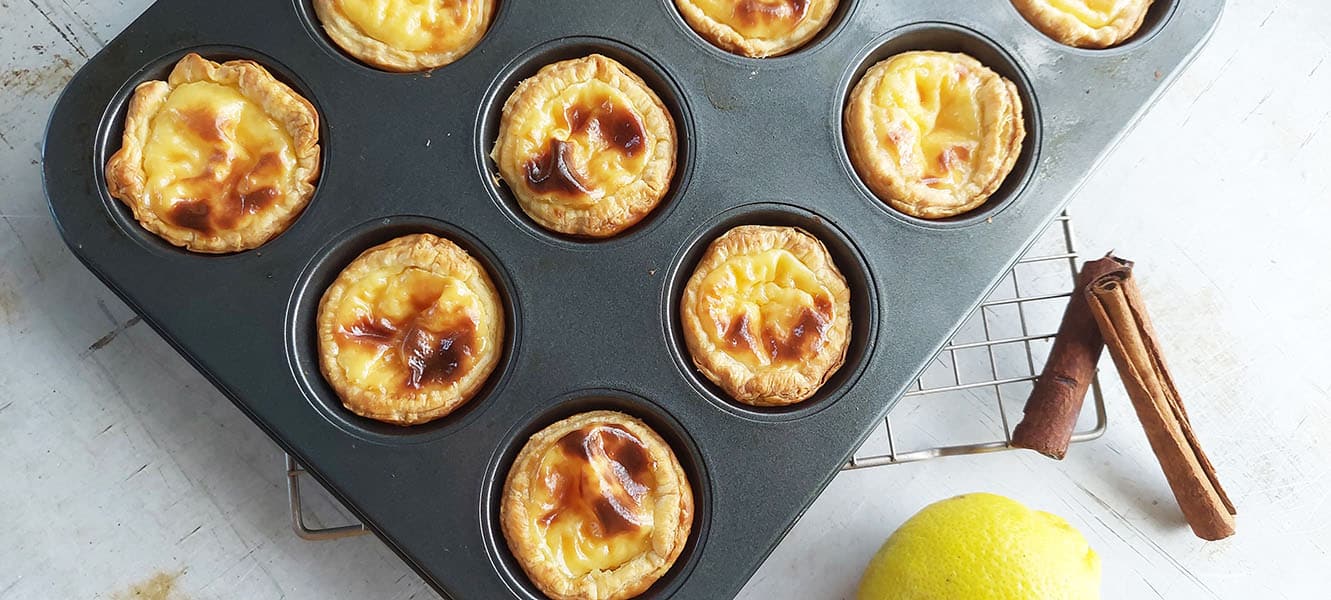

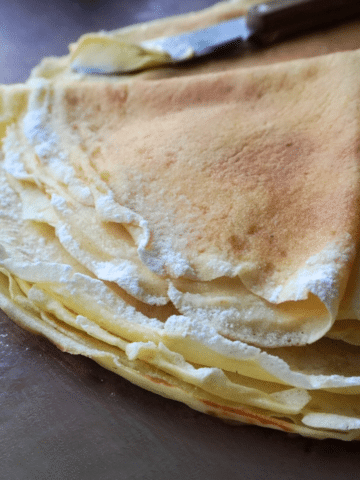
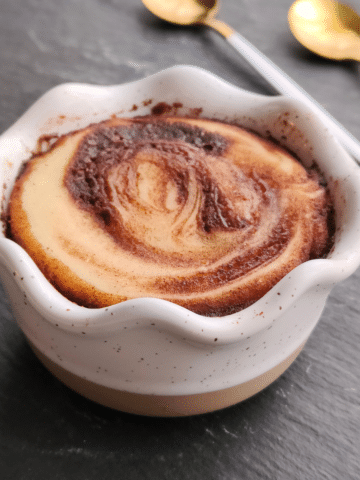
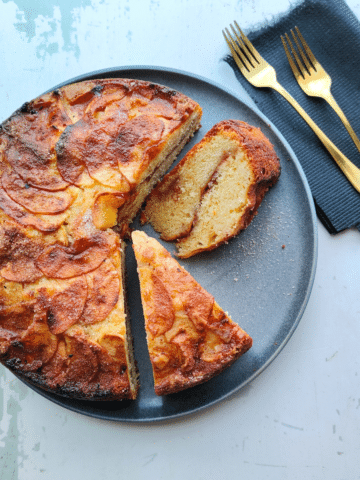
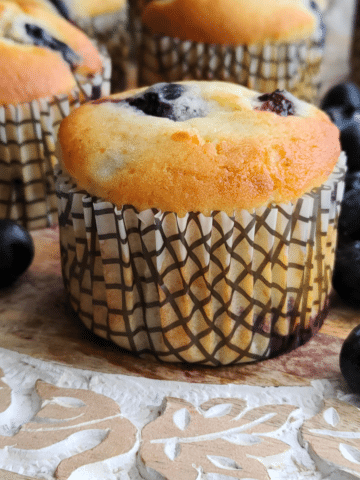

gary bird says
Made this recipe, very nice, after some experiments I finally found that 250c for 15 mins worked for me.
The Gardening Foodie says
Hi Gary, That's absolutely great.
Thank you for giving my recipe a try. I am really happy that it turned out well for you 😊